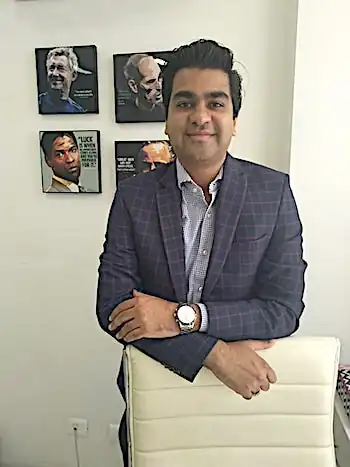
Rohit Singh is 38, with 14 years of uninterrupted professional experience behind him. At 21, this engineer from India’s hinterland began his career with a small test prep company. A year later, disillusioned by the possibilities there, he switched to a career in finance. In the next decade, he held progressively senior roles in corporate finance and later investment management in India and in the USA. “It was an exciting phase for me,” he says. “I was working with VC funds, understanding how the funding ecosystem works, and traveling the world at the same time.”
That run came to a halt in 2017. Owing to a mix of visa-related issues and opportunities in India, Rohit decided to return home to India. In India, he was fortunate to find an exciting role in media investments with one of India’s large media conglomerates. This was the time when institutional and foreign investors alike were pouring money into India’s growth story. Suddenly, multi-million dollar funding deals for Indian startups were not unheard of. One heard of Indian unicorns taking birth almost every month. However, while Rohit had a good role, suddenly, he found that taking that leap to senior management, despite his years of experience, was hard. Over the years, his technical and analytical skills had been his biggest strengths. Strategy and leadership are now much more important. Many of these require skills for which he can benefit deeply from business education.
Rohit, though, was not simply looking for career advancement. He was also looking at the possibility of career change, and to moving to roles in impact investing and fund management. “It seemed like an exciting world to me, one within reach, but somehow always outside my grasp. I interviewed with 4 funds in India, but all of them turned me down. While they had people who had grown organically without an MBA, they preferred lateral hires with an MBA.” That, though is something that Rohit neither had, and it seemed, nor was it something he could get. Rohit’s MBA boat had sailed long ago, and Rohit wasn’t on it.
FEW FULL-TIME OPTIONS FOR PROS WITH MORE THAN A DOZEN YEARS OF EXPERIENCE

Rishabh Gupta, founder of GyanOne Universal
There are very few options that someone with over 12 years of experience has. Most full-time MBA programs look at such candidates as too experienced to join the regular full-time MBA program. Many of these candidates do not want to join EMBA programs. A few look for a career reboot or at least a refresh, which EMBAs do not offer anyway. And yet, when such a candidate goes out to look for top MBA programs, there are few clear options out there. Even the one-year MBA programs offered by some schools (such as Kellogg and Cornell) may not be appropriate, because the target segment and peer group for even those programs is closer to that of full-time MBA programs.
If you’re in this boat, fret not. While you may not have a world of options before you, there are certainly some excellent choices out there that you could consider.
Among three of the best are the Sloan Fellows MBA programs: London Business School, MIT Sloan, and Stanford GSB offer a one-year cohort of what was originally called the Sloan Fellows MBA program. While that name still stands at MIT, LBS now calls it the Sloan Masters in Leadership and Strategy and Stanford calls it the MSx. While the concept behind the three programs is the same (targeted at mid-career professionals looking to move to senior management soon), the character of each of the three programs is a bit different along with the location.
STANFORD’S MSx PROGRAM ANOTHER OPTION
LBS, that has perhaps the most international and senior cohort of all the three programs (the current average experience for attending students is 18 years), focuses on strategic thinking, leadership development, and top management roles as focus areas for the program. While a wide array of electives is available, usually, people at this experience level would choose something adjacent to their current skills set than radically different. LBS is known to offer GMAT waivers for this program (on a case by case basis, though), so it may be a more attractive option for those who are just too busy to take the tests.
At MIT, one can choose a degree (among an SM in Management, an SM in Management Technology, or an MBA in Business Administration). With a cohort of 100 students with an average of 14 years of experience among them, the class is experienced and accomplished. Boston’s famous technology ecosystem, and MIT’s action-based learning methodology promise to deliver new ways of problem-solving and strategic thinking as key takeaways for the cohort. In the past, we have seen professionals across diverse areas benefit from the program, including a senior Indian administrator, who took back skills in financial analysis and digital transformation.
Stanford’s MSx program is perhaps the most ambitious of the three. Not only can you take courses focusing on a wide range of industries (including Education, Health Care, Energy, and Technology), but you can also choose one among three career paths in Career Advancement, Entrepreneurship, and Career Change. Stanford’s unique relationship with Silicon Valley means that this program is a godsend for those looking for opportunities in technology. Indeed, entrepreneurship (mostly related to technology) is a big draw, with Stanford reporting that 38 companies were started by MSx alumni in the 2016-18 period alone.
IBEAR, NANYANG FELLOWS & IMD
Interesting trivia: The Sloan Fellows programs are not new by any measure. The first one (at MIT) was founded in 1930, and the ones at Stanford and LBS launched in 1957 and 1968 respectively. The programs have a long and illustrious list of alumni.
The IBEAR MBA: Relatively younger to the Sloan Fellows programs (but still middle-aged in its own right, at 43 years old), the IBEAR MBA is another distinguished full-time MBA program offering for mid-career professionals. The class size for the program is fairly small (around 55-56 participants per cohort), and the class has an average of around 12 years of experience currently. It is drawn from 12 countries, with Asian candidates comprising the lion’s share of the class at 65%. The program boasts of a cutting-edge curriculum, and multiple experiential learning opportunities in the USA and abroad, including its famed International Business Consulting Projects. The program provides for a lot of flexibility, as 21 credit units of core classes can be waived to enable candidates to pursue specialization courses in a specific area. Located in LA, the program provides excellent access to Silicon Beach, and also has a dedicated career services office. This is also reflected in the fact that 25% of the class is ultimately recruited into tech, and a further 15% into e-commerce.
The Nanyang Fellows MBA program: Another key emerging option, in Asia, is the one-year long Nanyang Fellows full-time MBA program, that starts with a new class in July every year. The program requires applicants to have a minimum of 8 years of experience, and also has international segments at the University of California, Berkeley, and Tsinghua University. With just 25 people in each class, the Nanyang Fellows MBA provides for a highly personalized learning experience focused on Asia. The program also has dedicated career support, though past participants aver that lateral placements at the middle and senior management levels were mostly dependent on personal and school networks. The program website still has elements from the Class of 2015 listed on its website, and events and programs from years ago. Potential applicants would do well to coordinate with current students on career support and job opportunities in Singapore.
GETTING INTO LBS SLOAN FELLOWS WITHOUT A GMAT
Other full-time MBA programs that consider highly experienced candidates: While these programs are the mainstay of full-time MBA options for mid-career professionals, there are a handful of other programs that are usually quite open to consider MBA candidates with 12+ years of experience. These include the full-time HKUST MBA (Hong Kong University of Science and Technology, Hong Kong), the IESE MBA (University of Navarra, Spain), the Sauder MBA (University of British Columbia, Canada), and the Schulich MBA (University of York, Canada).
Among top programs, IMD is another school that regularly admits candidates with 10+ years of experience. INSEAD used to do that too, but over the last couple of years has been reluctant to consider candidates with over a decade of experience. For Indian candidates, the IIM experienced MBA programs (IIM Ahmadabad PGPX, IIM Calcutta MBAEx, and IIM Lucknow IPMX).
PS – And Rohit? He ultimately chose to apply to the LBS Sloan Fellows program, without a GMAT score, and was accepted. He matriculated last year, and is currently negotiating the vagaries of the pandemic on mid-management hires. He remains confident that the program provided him strong value, and he will be able to ultimately build a much more enriching career.
Rishabh Gupta is the founder and a partner at GyanOne Universal in New Delhi. He was named one of the top 20 MBA admission consultants of 2020 by Poets&Quants.
DON’T MISS: Top 5 Myths Of Indian MBA Applicants To Top B-Schools





Questions about this article? Email us or leave a comment below.